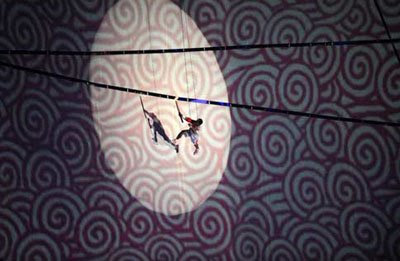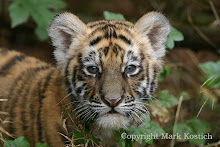






---------------------------------- Notes -----------------------------------




 There were a total of 29 footprints, symbolising the 28 Olympic games prior to the Beijing Olympics & 29th Olympic games at Beijing.
There were a total of 29 footprints, symbolising the 28 Olympic games prior to the Beijing Olympics & 29th Olympic games at Beijing. 
At the 29th footprint above the National Stadium's sky, 20 Chinese Fairies descended from the "heaven" together with the falling stars (fireworks)

 Illuminated Chinese Fairy
Illuminated Chinese Fairy
 The falling stars slowly formed the Olympic rings as fairies hovering above it.
The falling stars slowly formed the Olympic rings as fairies hovering above it. Then, came the amazing moment when the Olympic Rings were lifted up high vertically, changing from 2-D image to become 3-D. That was really unexpected and the lifting scene was really surprising and a dazzling moment to me. It is like Magic!
Then, came the amazing moment when the Olympic Rings were lifted up high vertically, changing from 2-D image to become 3-D. That was really unexpected and the lifting scene was really surprising and a dazzling moment to me. It is like Magic!
 Each ring holds 45,000 beads of lights, wow!
Each ring holds 45,000 beads of lights, wow!

Next, 56 children in their individual ethnic costume, representing the 56 ethnic groups of modern China, marched the flag of People's Republic of China before handing it to the People Liberation Army soldiers.

"歌唱祖国" [Ode To The Motherland] was performed (lips sync) by 9 years old Lin Mioke (right photo) during the march of flag by the 56 children.
The song was actually sung by by 7 years old Yang Peiyi (Left photo).

Lin Mioke was chosen to performed the song due to her stronger stage presence over Yang Peiyi. Poor Yang Peiyi, she must be hurted to know as she was not chosen to perform on stage due to her look!

China's flag was raised and national anthem was sung.

Next was the art performances, titled "TheBeautiful Olympics", which was consisted of 2 parts - Glorious Civilisation 灿烂文明 & Glorious Age 辉煌时代
The art performnaces revolve around Chinese culture and the great inventions of ancient China, i.e. paper, the compass and printing (woodblock and movable block), as well as silk road (land and sea)

After the screening short film of Paper Making - one of the four great inventions of the Chinese, The Scroll was revealed from the central stage.
---------------------------Notes----------------------------
The first papermaking process was developed in China during the early 2nd century BC. It was used for purpose of wrapping or padding protection for delicate bronze mirrors. Also, use for safety, such as padding poisonous medicine. Paper used for writing became widespread by the 3rd century
Before the invention of paper, documents of ancient China were written on bone or bamboo (on tablets or on bamboo strips sewn and rolled together into scrolls), which were heavy to transport. The light material of silk was sometimes used, but was normally too expensive to consider.
Han Dynasty Chinese court official Cai Lun is widely regarded to have invented the modern method of papermaking (inspired from wasps and bees) from rags and other plant fibers in AD 105, the discovery of specimens bearing written Chinese characters in 2006 at north-east China's Gansu province suggest that paper was in use by the ancient Chinese military more than 100 years before Cai, in 8 BC. Archeologically however, true paper without writing has been excavated in China dating to the reign of Emperor Wu of Han from the 2nd century BC.
-----------------------------------------------------------

The Scroll and the stage were actually giant LED display. As the Scroll unfurl, pictures of ceramics, proceline & chinese fine arts were beamed. Throughout the evening, both the scrolls and the painting constantly change their images.

Loacted at the central stage was a piece of canvas, measuring 20m X 11m, 20mm thick and weighing 800 kg, where a dozen dancers danced, accompanies by the sound of "古琴" [guqin], a 7 strings ancient chinese musical instrument; and was using their bodies as paintbrushes. The trails of these dancers left a drawing, reminiscing a Chinese ink painting. The perfromance is one of my most favoraite performances of that evening.
The trails of these dancers left a drawing, reminiscing a Chinese ink painting. The perfromance is one of my most favoraite performances of that evening.
The Beijing Opera Puppet perfromance filled in the time gap while the backstage was busy preparing for the subsequent Movable Type Press performance, another great Chinese Invention.
Honestly, I found the scale was abit too small. In addition, the puppet show should be replaced or accompanied by real Beijing Opera actors.
Skillful Puppet Master dressed in black injecting life and characters to the puppets.






























.bmp)
.bmp)









































